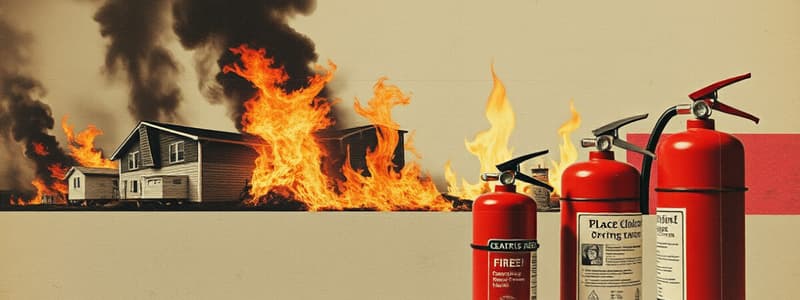Podcast
Questions and Answers
Match the classification of a fire with an example of the fuel:
Match the classification of a fire with an example of the fuel:
Class A = Paper or wood Class B = Flammable liquids Class C = Electrical charge Class D = Combustible metals Class K = Cooking oils and fats
The first action you should take when using a fire extinguisher is to ______.
The first action you should take when using a fire extinguisher is to ______.
Pull the pin
When using a fire extinguisher, you should aim low and point at the ______.
When using a fire extinguisher, you should aim low and point at the ______.
base of the fire
After using a fire extinguisher, you should ______.
After using a fire extinguisher, you should ______.
What classification of fire do you need for a fire fueled by cardboard boxes?
What classification of fire do you need for a fire fueled by cardboard boxes?
What does the 'A' in P.A.S.S. represent?
What does the 'A' in P.A.S.S. represent?
What should you do if a fire in your workplace appears to be spreading rapidly?
What should you do if a fire in your workplace appears to be spreading rapidly?
What types of fires can an A-B-C extinguisher extinguish?
What types of fires can an A-B-C extinguisher extinguish?
What is important to remember when deciding to fight a small workplace fire?
What is important to remember when deciding to fight a small workplace fire?
Which of the following factors is important when using a fire extinguisher? (Select all that apply)
Which of the following factors is important when using a fire extinguisher? (Select all that apply)
After successfully putting out a workplace fire, which of the following actions should you take? (Select all that apply)
After successfully putting out a workplace fire, which of the following actions should you take? (Select all that apply)
Flashcards are hidden until you start studying
Study Notes
Fire Classifications
- Class A fires involve ordinary combustibles like paper or wood.
- Class B fires are related to flammable liquids such as gasoline or oil.
- Class C fires are electrical in nature, involving electrical equipment.
- Class D fires involve combustible metals like magnesium and aluminum.
- Class K fires are associated with cooking oils and fats, typically found in kitchens.
Using a Fire Extinguisher
- Follow the P.A.S.S. technique when using a fire extinguisher:
- Pull the pin to unlock the extinguisher.
- Aim low at the base of the fire to target the source.
- Squeeze the handle to release the extinguishing agent.
- Sweep the nozzle from side to side to cover the fire area effectively.
Fire Extinguisher Considerations
- Fire extinguishers have a limited range, typically requiring close proximity to the fire.
- Each extinguisher contains a finite amount of extinguishing agent, which may not suffice for larger fires.
- Fire extinguishers are designed for small fires; if flames spread, evacuate.
Immediate Actions in Fire Situations
- In case of a spreading fire, evacuate the area immediately and close the nearest fire door to contain the flames.
- After using a fire extinguisher, inform the appropriate personnel for recharging or replacement.
Types of Fire Extinguishers
- A-B-C extinguishers are versatile, effective against Class A (wood), Class B (paint), and Class C (electrical) fires.
Post-Fire Actions
- After extinguishing a fire, ensure no hot embers remain and no combustible materials are left that could reignite.
- Properly dispose of all burned materials to prevent further fires.
- Report the usage of the extinguisher to ensure it is serviced and ready for future use.
Safety Reminders
- Always maintain a clear and accessible exit route when confronting a small fire to ensure personal safety.
Studying That Suits You
Use AI to generate personalized quizzes and flashcards to suit your learning preferences.




